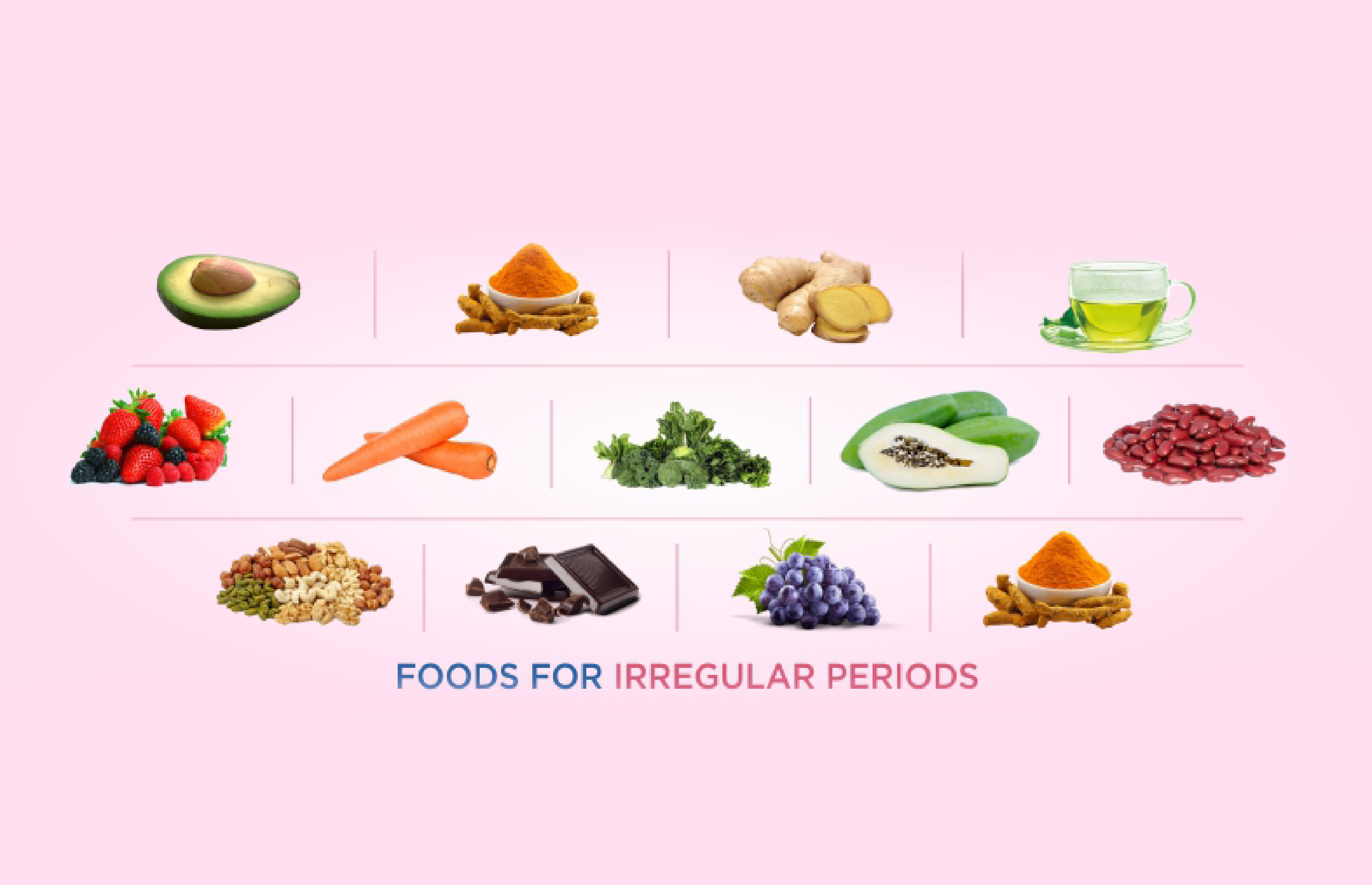What to Eat For a healthy menstrual cycle, eat nutrient-dense foods like leafy greens, whole grains, lean proteins, and healthy fats. Avoid processed foods and excessive sugar.
Maintaining a balanced diet is essential for a healthy menstrual cycle. Nutrient-rich foods support hormone regulation and reduce menstrual symptoms. Leafy greens, such as spinach and kale, provide vital vitamins and minerals. Whole grains offer fiber that aids digestion and stabilizes blood sugar levels.
Lean proteins, like chicken and fish, supply necessary amino acids. Healthy fats from sources like avocados and nuts support hormonal balance. It’s important to minimize processed foods and sugar intake, which can exacerbate symptoms. Staying hydrated and incorporating a variety of these foods can significantly improve menstrual health and overall well-being.
Introduction To Menstrual Health
What to Eat for Healthy Menstrual Cycle is essential for women’s well-being. It affects physical and emotional health. Proper nutrition plays a significant role in menstrual health. Eating the right foods can reduce symptoms and improve overall health.
The Link Between Diet And Menstrual Health
Diet directly impacts menstrual health. Certain foods can help balance hormones. They also support the reproductive system. A balanced diet can ease cramps and reduce bloating. It can also regulate the menstrual cycle.
Foods rich in vitamins and minerals are crucial. They provide the body with necessary nutrients. These nutrients are vital for hormone production. They also support the menstrual cycle.
Why Nutrition Matters
Nutrition affects every aspect of health. A nutrient-rich diet supports a healthy menstrual cycle. It helps maintain hormone levels. It also boosts energy and reduces fatigue.
The following table shows important nutrients and their sources:
| Nutrient | Food Sources |
|---|---|
| Iron | Spinach, red meat, lentils |
| Calcium | Dairy products, almonds, kale |
| Magnesium | Nuts, seeds, whole grains |
| Vitamin B6 | Bananas, chickpeas, fish |
Including these foods in your diet can make a big difference. They provide essential nutrients. These nutrients support a healthy menstrual cycle.
Iron-rich Foods To Combat Fatigue
What to Eat for Healthy Menstrual Cycle can get disrupted by fatigue. This often occurs due to iron loss. Consuming iron-rich foods is crucial. These foods help replenish iron levels in your body. This section will highlight sources of iron and ways to incorporate them into your diet.
Sources Of Iron
Iron can be found in two forms: heme and non-heme. Heme iron comes from animal sources. Non-heme iron is found in plants. Here are some excellent sources:
| Food | Type of Iron |
|---|---|
| Red meat | Heme |
| Poultry | Heme |
| Fish | Heme |
| Spinach | Non-heme |
| Lentils | Non-heme |
| Tofu | Non-heme |
Incorporating Iron Into Your Diet
It is important to include iron in your daily meals. Here are simple ways to do that:
- Start your day with a spinach smoothie.
- Add lentils to your soups and salads.
- Include red meat or poultry in your dinner.
- Snack on a handful of pumpkin seeds.
- Combine non-heme iron foods with vitamin C. This improves absorption.
Iron is crucial for energy and fighting fatigue. Eating a variety of iron-rich foods will support your menstrual health.
Magnesium For Cramp Relief
Magnesium is a crucial mineral for easing menstrual cramps. It helps relax muscles and reduce pain. Including magnesium-rich foods in your diet can make a big difference.
Benefits Of Magnesium
Magnesium offers several benefits for menstrual health:
- Relieves cramps: Magnesium helps relax uterine muscles, easing cramps.
- Reduces inflammation: It lowers inflammation, reducing pain and swelling.
- Boosts mood: Magnesium supports serotonin production, improving mood.
- Improves sleep: It can help you sleep better during your period.
Magnesium-rich Foods
Include these foods in your diet to boost magnesium intake:
| Food | Magnesium (mg) |
|---|---|
| Spinach | 157 |
| Almonds | 80 |
| Black Beans | 120 |
| Dark Chocolate | 64 |
| Avocado | 58 |
Try adding these foods to your daily meals. You can make a spinach salad, snack on almonds, or enjoy a piece of dark chocolate. These simple changes can help manage menstrual cramps effectively.

Credit: www.pinterest.com
Omega-3s To Reduce Inflammation
Many women experience menstrual discomfort. Diet plays a key role in managing these symptoms. One significant dietary component is omega-3 fatty acids. These fatty acids help reduce inflammation and alleviate menstrual pain. Including omega-3s in your diet can make a difference.
Understanding Omega-3s
Omega-3s are essential fatty acids. The body cannot produce them. You must get them from your diet. They have many health benefits, including reducing inflammation. They help lower the production of inflammatory substances. This is especially beneficial for menstrual health.
There are three main types of omega-3s:
- ALA (Alpha-linolenic acid)
- EPA (Eicosapentaenoic acid)
- DHA (Docosahexaenoic acid)
ALA is found in plant oils. EPA and DHA are found in marine oils. All three types are vital for reducing inflammation.
Foods High In Omega-3
Incorporate these foods into your diet to boost omega-3 intake:
- Fatty Fish: Salmon, mackerel, sardines, and trout are excellent sources.
- Seeds: Flaxseeds and chia seeds are rich in ALA.
- Nuts: Walnuts provide a good amount of omega-3s.
- Plant Oils: Flaxseed oil and canola oil are beneficial.
- Seaweed and Algae: Good sources of DHA, especially for vegetarians.
Consider consuming fish at least twice a week. Add seeds and nuts to your snacks and meals. Use plant oils in your cooking and salads.
The table below shows the omega-3 content in various foods:
| Food | Omega-3 Content (per serving) |
|---|---|
| Salmon | 2,260 mg |
| Mackerel | 4,107 mg |
| Flaxseeds | 2,338 mg |
| Chia Seeds | 4,915 mg |
| Walnuts | 2,542 mg |
By adding these foods to your diet, you can reduce inflammation and ease menstrual pain. Omega-3s are a natural way to support your menstrual health.
Calcium For Pms Symptoms
Calcium for PMS Symptoms can play a crucial role in managing discomforts. Many women experience premenstrual syndrome (PMS) symptoms like mood swings, cramps, and bloating. Adding calcium to your diet may help ease these symptoms. This blog section will explore the importance of calcium and where to find it in foods.
The Role Of Calcium
Calcium helps the body in many ways. It supports bone health, muscle function, and nerve signaling. For women, calcium can reduce PMS symptoms. Studies show that calcium reduces mood swings, bloating, and cramps. It helps balance hormones, which can lower PMS discomforts.
Calcium Sources
There are many foods rich in calcium. Here are some options:
- Dairy products: Milk, cheese, and yogurt are high in calcium.
- Leafy greens: Kale, spinach, and broccoli are good choices.
- Nuts and seeds: Almonds and chia seeds contain calcium.
- Fortified foods: Some cereals and orange juices have added calcium.
| Food Item | Calcium Content (mg per serving) |
|---|---|
| Milk (1 cup) | 300 |
| Yogurt (1 cup) | 450 |
| Kale (1 cup, cooked) | 100 |
| Almonds (1 ounce) | 75 |
Adding these foods to your diet can boost your calcium levels. Aim to get enough calcium each day. Women need about 1,000 mg of calcium daily. This can help reduce PMS symptoms and improve overall health.

Credit: www.motherhoodchaitanya.com
Fiber For Hormonal Balance
Maintaining a healthy menstrual cycle can be challenging. Eating the right foods helps balance your hormones. One essential nutrient is fiber. Fiber plays a crucial role in regulating your hormones.
Why Fiber Is Key
Fiber helps your body eliminate excess hormones. It binds to estrogen and removes it through digestion. This process keeps estrogen levels balanced. Balanced hormones mean fewer menstrual issues.
Fiber also stabilizes blood sugar levels. Stable blood sugar reduces PMS symptoms. It keeps energy levels steady and reduces mood swings.
High-fiber Foods
Incorporate high-fiber foods into your diet for hormonal balance. Here are some excellent options:
| Food | Fiber Content (per 100g) |
|---|---|
| Avocado | 7g |
| Chia Seeds | 34g |
| Broccoli | 2.6g |
| Raspberries | 6.5g |
| Lentils | 7.9g |
These foods are easy to add to your meals. Start your day with a chia seed smoothie. Add avocado to your salad. Enjoy broccoli as a side dish. Snack on raspberries. Include lentils in soups and stews.
Eating more fiber-rich foods helps balance your hormones. A balanced diet leads to a healthier menstrual cycle. Make these small changes for big health benefits.
Vitamin B For Mood And Energy
Maintaining a What to Eat for Healthy Menstrual Cycle can be challenging. One key to feeling better is Vitamin B. This group of vitamins helps balance mood and energy levels. Let’s explore how Vitamin B can help.
Types Of B Vitamins
There are several types of B vitamins, each with unique benefits:
- Vitamin B1 (Thiamine): Helps convert food into energy.
- Vitamin B2 (Riboflavin): Supports cell growth and function.
- Vitamin B3 (Niacin): Aids in digestion and skin health.
- Vitamin B5 (Pantothenic Acid): Assists in hormone production.
- Vitamin B6 (Pyridoxine): Important for brain health.
- Vitamin B7 (Biotin): Keeps hair, skin, and nails healthy.
- Vitamin B9 (Folate): Crucial for red blood cell formation.
- Vitamin B12 (Cobalamin): Supports nerve function and blood cell health.
B Vitamin Sources
Incorporate these foods into your diet to boost your Vitamin B intake:
| B Vitamin | Food Sources |
|---|---|
| Vitamin B1 | Whole grains, nuts, seeds |
| Vitamin B2 | Dairy products, eggs, green vegetables |
| Vitamin B3 | Meat, fish, legumes |
| Vitamin B5 | Chicken, avocados, broccoli |
| Vitamin B6 | Bananas, chickpeas, potatoes |
| Vitamin B7 | Egg yolks, nuts, soybeans |
| Vitamin B9 | Leafy greens, citrus fruits, beans |
| Vitamin B12 | Fish, meat, dairy products |
By including these foods in your diet, you can support a healthy menstrual cycle. Vitamin B is essential for mood and energy.
Hydration And Menstrual Health
Hydration is vital for a healthy menstrual cycle. Drinking enough water can reduce cramps and bloating. It also helps maintain energy levels. Staying hydrated supports overall menstrual health.
Importance Of Staying Hydrated
Water helps regulate body temperature and lubricate joints. It also aids in nutrient absorption. Proper hydration can ease menstrual symptoms. Dehydration can worsen cramps and headaches.
Staying hydrated supports kidney function. It also helps flush out toxins. This can lead to clearer skin. Hydration can improve your mood and concentration.
Tips For Increasing Water Intake
- Carry a water bottle everywhere.
- Set reminders to drink water.
- Drink a glass of water before each meal.
- Add slices of fruit for flavor.
- Eat water-rich foods like cucumbers and watermelon.
Using a water tracking app can also help. Aim for at least eight glasses daily. Adjust based on your activity level.
Putting It All Together
Managing your What to Eat for Healthy Menstrual Cycle through diet can be effective. Incorporating a balanced diet ensures your body gets essential nutrients. Let’s put all the pieces together.
Creating A Balanced Meal Plan
A balanced meal plan includes all food groups. Aim for a mix of proteins, carbs, and healthy fats. Here’s a simple table to guide you:
| Meal | Food Items |
|---|---|
| Breakfast | Oatmeal with berries and nuts |
| Lunch | Grilled chicken with quinoa and vegetables |
| Dinner | Salmon with brown rice and steamed broccoli |
| Snack | Greek yogurt with honey |
Listening To Your Body
Listening to your body helps in understanding your needs. Notice how you feel after eating certain foods. Pay attention to hunger and fullness cues.
Here are some tips to help you:
- Eat small meals throughout the day.
- Stay hydrated with water and herbal teas.
- Avoid processed foods and sugary snacks.
These practices help in maintaining a healthy menstrual cycle. Always consult a healthcare provider for personalized advice.

Credit: www.sheknows.com
Frequently Asked Questions
What Food Is Good For Menstrual Cycle?
Leafy greens, fish, nuts, and seeds help maintain a healthy menstrual cycle. Fruits, whole grains, and yogurt are also beneficial.
How Can I Make My Period Cycle Healthy?
Maintain a healthy period cycle by eating balanced meals, exercising regularly, staying hydrated, managing stress, and getting enough sleep.
What Nutrients Does Your Body Need During Menstruation?
Your body needs iron, calcium, magnesium, vitamin B6, and omega-3 fatty acids during menstruation. These nutrients help reduce cramps, fatigue, and mood swings.
Can Your Diet Affect Your Period Flow?
Yes, your diet can affect your period flow. Nutrient-rich foods may help regulate it, while poor diet can cause irregularities.
Conclusion
A balanced diet is key for a healthy menstrual cycle. Include iron-rich foods, leafy greens, and whole grains. Hydration and exercise also play crucial roles. Focus on nutritious choices to support your overall well-being. Small dietary changes can make a big difference in your menstrual health.
Start today for a healthier tomorrow.




Leave a Reply